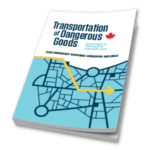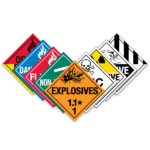 Transport Canada Publishes Site Registration Amendment to Transportation of Dangerous Goods Regulations
Transport Canada Publishes Site Registration Amendment to Transportation of Dangerous Goods Regulations
Just when you thought the Canadian “Transportation of Dangerous Goods Regulations” (TDGR) were not going to be subject to much more than tweaks to the current system, Transport Canada has introduced an amendment creating an entirely new part with a requirement for participants in the transportation of dangerous goods. Those who handle, offer for transport, transport or import dangerous goods will be required to register with the government. However, the current amendment is not as far-reaching as previous proposals, to the relief of many stakeholders. Original fears that this new requirement, referred to as the Client Identification Database (CID), would be unduly difficult or expensive to comply with have been relieved with the publication of a short and reasonably low-cost procedure.
The CID requirement is not part of the system created by the United Nations in their Recommendations on the Transport of Dangerous Goods. However, it does bear a resemblance to the requirements in the United States “Hazardous Materials Regulations,” sections 107.601 to 620, where shippers and carriers of certain types of shipments must register.
The Site Registration Amendment
This amendment was published on October 25, 2023 (although it was registered for publication on October 6). The text of the amendment can be found in Canada Gazette, Part II, Volume 157, Number 22. Since it has been published in Canada Gazette, Part II, this is a “final rule” and will take effect immediately, although a one-year transition period is included in the text.
Since there was some negative feedback to Transport Canada’s initial proposal, this new registration is simpler and should be less cumbersome for participants. However, it will require organizations to do an initial review of what dangerous goods they ship, transport or import, and to designate employees who must do the actual registration.
What Will Change in TDGR?
This amendment will add a new Part (chapter) to the TDGR, which will introduce the requirement for shippers, carriers, other handlers and importers to register. It will also modify a few “special cases” in Part 1. These exemptions list the parts of the TDG that don’t apply in certain cases, so “Part 17” would be added.
The special cases that will be amended include:
- Section 1.17, Limited Quantities
- Section 1.19.1 and 1.19.2, which exempt many samples for classifying, testing, analysis or demonstration
- Section 1.22, the 3000 kg farm retail exemption
- Section 1.32, the exemption for gases in refrigerating machines
- Section 1.39, biological substances in Category B (UN3373)
- Section 1.41, biological substances such as vaccines
- Section 1.42, human or animal substances believed not to be infectious
- Section 1.42.2, blood or blood components
- Section 1.43.3, medical or clinical waste
- Section 1.43, excepted packages of radioactive substances
- Section 1.47, fire extinguishers
The new Part 17 will be very short, with only six sections. Section 17.1 defines the meaning of “site” as “a permanent location where dangerous goods are imported, offered for transport, handled or transported and are in the direct possession of a person conducting these activities, but does not include a location where dangerous goods are used only in the scope of a person’s work or as raw materials in products that they manufacture.” This clarifies that the site registration requirements apply to locations as opposed to people such as independent truck drivers.
Section 17.2 sets out the people who will be required to register and, also importantly, who do not have to register. First, it says the Part “applies to a person who imports, offers for transport, handles or transports dangerous goods at a site located in Canada that they own or operate.” People who do not have to register their sites include:
- Anyone who imports, offers for transport, handles or transports dangerous goods that come into Canada from outside the country and then move to a destination outside of Canada without any transport-related “handling” occurring in Canada (such as a rail line that cuts through Canada but begins and ends in the United States.)
- Anyone conducting movements across the Canada-U.S. border who does not have a headquarters in Canada or operate a site in Canada where regulated activities such as handling or offering for transport occur.
- Anyone who performs the basic functions (handling, offering for transport, transporting or importing) at a site where the goods are “in quantities necessary for a federal, provincial or municipal officer to carry out their duties with respect to the enforcement of federal, provincial or municipal law.”
- Those persons operating oil wells.
What’s Involved in Registration?
Section 17.3 sets out the basic requirements for registration. If you perform any of the regulated activities at your site in Canada, you must register the following information on a web portal created by Transport Canada. Information that must be included in the registration will be fairly minimal but will give Transport Canada an understanding of the scope of dangerous goods transport across the country. Since a 2011 audit by the Office of the Commissioner of the Environment and Sustainable Development (CESD) highlighted that Transport Canada had no way to identify or measure who is involved in transport of dangerous goods, or what types of dangerous goods are shipped by which organizations, the registration will be aimed at creating a “snapshot” of each company’s dangerous goods profile. To the relief of many, this does not include real-time tracking of dangerous goods shipments, or even estimated quantities.
Data to be provided includes:
- The business number assigned to the company or person by the Canada Revenue Agency (if applicable)
- The name and the address of organizational headquarters
- Phone numbers and email addresses of a contact person for the organization and also their replacement when absent
- Addresses of all sites where dangerous goods are imported, offered for transport, handled or transported by the organization
- The mode(s) of transport of dangerous goods used at each site
- For each site, the classes and divisions of dangerous goods that were imported, offered for transport, handled or transported within the previous fiscal year (if any)
- For each site, the importing, offering for transport, handling or transporting activities that were undertaken in the previous fiscal year (if any)
Section 17.3.1 then explains that you will have 12 months from the initial date of importing, handling, offering for transport or transporting of the substance to enter it on the registration database. This establishes, in effect, a one-year transition period for registration. Note that one year after publication, this section will be deleted from the regulations, so it will not be a permanent provision for a one-year timeframe for registration.
Finally, section 17.4 sets up requirement for an annual renewal of the registration (within 30 days of initial registration date), and section 17.5 requires those who have registered to update any change to the database within 60 days.
Currently, unlike the registration for hazmat shippers and carriers in the United States, there is no mention of a fee for registration. This does not, of course, rule out that some sort of cost-recovery might be brought in at a later time.
Guidance for Registrants
Transport Canada has established a webpage of helpful guidance materials for those affected by the new requirements. These include the link to the registration portal, user guides and a frequently-asked questions section.
If you need to contact Transport Canada directly for answers to questions the webpage doesn’t address, you can send your enquiries in writing using this link.
Conclusions
The Client Identification Database created a major ripple among Canadian industry when it was first proposed, but it appears that it will be a fairly small annual requirement. It should, it’s hoped, help Transport Canada get a clearer picture of dangerous goods operations across Canada and be a useful tool in improving the TDGR and related safety systems.
Questions?
Do you have questions about Regulations? Our team of experts is just a call away for our customers at 855.734.5469 or send us an email, we’re happy to help. We can advise you how to comply with current and upcoming regulations.
Stay up to date and sign up for our newsletter!
We have all the products, services, and training you need to ensure your staff is properly trained and informed.
 Glass Shipping Kits Glass Shipping Kits |
 Canadian TDG Publications Canadian TDG Publications |
 Worded Placards Worded Placards |
References:
Canada Gazette, Part II, Volume 157, Number 22, “Regulations Amending the Transportation of Dangerous Goods Regulations (Site Registration Requirements): SOR/2023-206”

 Transport Canada Publishes Site Registration Amendment to Transportation of Dangerous Goods Regulations
Transport Canada Publishes Site Registration Amendment to Transportation of Dangerous Goods Regulations



